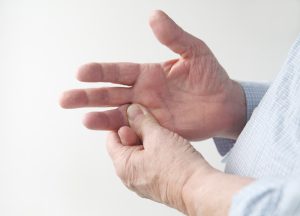Trigger Finger / Thumb

What is it?
Also known as stenosing tenosynovitis, trigger finger (or thumb) is the inflammation and thickening of the tissues surrounding the tendons that allow bending movements of the fingers.
Muscles in the forearm are connected to the fingers via tendons. These tendons are surrounded by a sheath and are enclosed by pulleys that maintain a close relationship between the tendon and bone.
In trigger finger the sheath and pulley become inflamed and the tendon may also form a nodule within it. As a result the finger tendon experiences a high resistance to movement and may become stuck, leading to catching or locking of the finger whilst trying to straighten and extend it. Repeated catching and locking may exacerbate the inflammation and worsen the symptoms.
Who gets it and what causes it?
There is no clear cause but there are associations with rheumatoid arthritis, gout and diabetes.
What are the signs and symptoms?
You may experience difficulty in straightening and bending your finger (or thumb), and it may become locked or trapped in a certain position. Patients often experience pain and tenderness at the base of the finger, and may feel a small lump along the tendon.
What tests will I need?
The diagnosis can usually be made with a consultation, involving a medical history and clinical examination. No specialised tests are needed.
What is the treatment?
There are a few conservative treatment measures including the wearing of a splint, undertaking hand exercises, modification of normal activities and taking oral anti-inflammatory medications.
Steroid injections around the tendon at the point of triggering are usually the next line of treatment. They help to reduce the inflammation and restore some of the freedom of movement of the tendon through its sheath and pulley. The steroid may take a few weeks to take maximal effect. Persistent or severe symptoms are likely to require surgical treatment.
What does the surgical treatment involve?
Surgery aims to release the tendon from the inflamed sheath and pulley by making a small cut.
Mr. Naqui performs trigger finger release surgery at a number of hospitals around Manchester (See Hospitals page). The surgery usually lasts 15 to 20 minutes and is usually a day case procedure requiring only local anaesthetic (see FAQs page). The surgical scar is usually 1 to 2 cm long and stitches will be used to close the wound. A bandage is placed over the stitches.
What happens after the surgery?
Taking simple painkillers such as paracetamol regularly for the first 2 days after the operation will help to relieve any post-operative pain. Finger exercises should be performed immediately after surgery. Stitches will be removed at 10-14 days after the operation either at your GP or at the Hand clinic.
When I can return to normal activity?
If you perform heavy lifting at work it is advised to stay off work for 4-6 weeks; otherwise a period of 1-2 weeks off work is recommended to allow you to recover.
You are not advised to drive for 1 week after surgery.
Mr. Naqui will discuss your return to sport with you, depending upon your needs.
What are the complications of surgery?
Complications are unlikely. There are small risks of infection, nerve or tendon injury and recurrence of symptoms.





